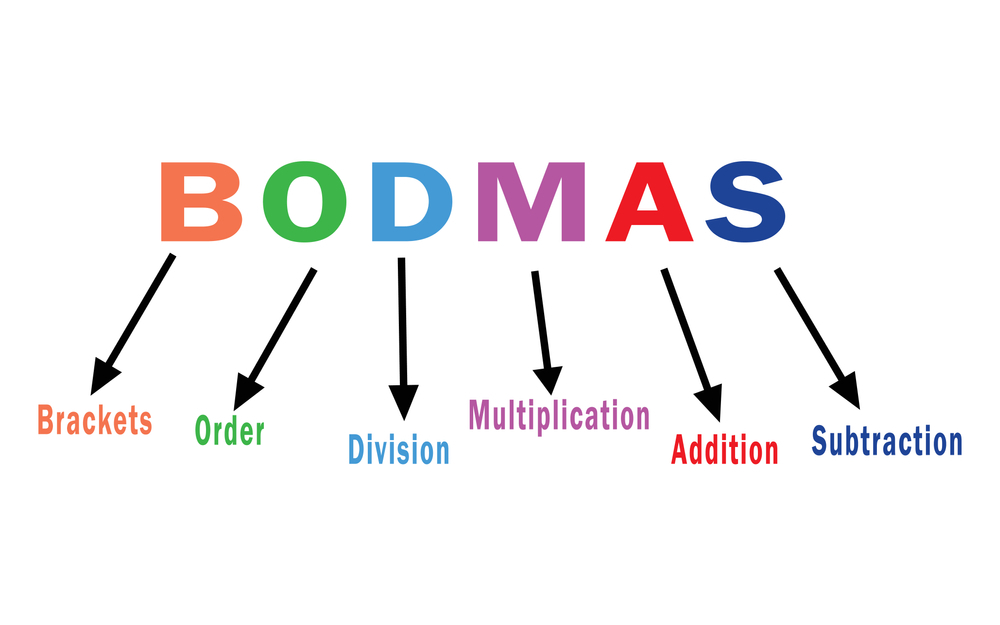
Mathematics is the second name of logic and rules. If it weren’t for the standard rules of mathematics, calculation in maths would have been extremely tough to figure out. Basic mathematical operations that we all study in school are subtraction (−), addition (+), multiplication (×), and division (÷), etc. These symbols called operators are used in between two numbers present in an equation or expression. An expression is the combination of arithmetic operators and numbers with the former present in between the latter.
Now, let’s consider a simple expression with numbers and operators:
(8+5×22+1)
If you see this expression in an exam, what part will you solve first and what parts will you solve after it? Will you start from the right and go to the left or will you start solving from the left and end at the right? Also, keep in mind that using the wrong order to solve the expression will result in the wrong answer and the deduction of marks from your final grade. So, what will you do?
Lucky for you, there is a way to solve these expressions in the right order to get the correct answer. Do you want to know about the order that people agreed to follow many years ago, so they can solve mathematical equations the same way without any conflict?
The principle that our ancestors agreed upon long ago is known as the BODMAS principle which refers to the sequence or order of operations that one must follow when solving a mathematical problem.
Related Read: https://mytutorsource.ae/blog/mathematical-functions-mean-median-mode-and-range/
What is BODMAS Rule?
BODMAS is an acronym that represents Brackets, Order, Division, Multiplication, Addition, and Subtraction. In some parts of the world, students follow the PEMDAS rule while in other parts of the world BIDMAS is also used by students. We have touched on both PEMDAS and BIDMAS later in the article, so keep an eye out for them:
Coming back to BODMAS, BODMAS explains the order in which mathematical operations have to be performed when solving an expression in maths. According to the BODMAS rules in maths, if there are multiple brackets (vinculum,+,×,÷) in an expression, the correct order is to start solving them from inside the vinculum or line or bar bracket, then solve the round bracket followed by curly bracket, square bracket and lastly the order which means roots and power before solving the division, multiplication, addition, and, in the end, subtraction.
So, the BODMAS theory is used to evaluate and calculate complex mathematical equations in a much easier and correct way.
Definition of BODMAS Rule
According to the BODMAS rule, if you want to solve a mathematical expression, start with the terms present inside the brackets, after that simplify the exponential terms, and then go to the division and multiplication operations, then, at the very last, do the addition and subtraction.
In other words, multiplication and division are the level one operations because you must solve them first, and addition and subtraction are level two operations. You can directly simplify the terms inside the brackets, therefore, you can do the operations inside it in the correct order i.e., division, multiplication, addition, and subtraction.
If you stick to this order of operations and follow the BODMAS rule, you will always get the correct answer. If there are multiple brackets in your math problem, you can solve all the same types of brackets simultaneously.
The Correct Order of BODMAS Rule in Maths
The correct order of using the BODMAS rule in maths is:
- Brackets (these include parts of an expression inside the brackets and they always come first).
- Orders (these are the numbers involving square roots or powers).
- Division.
- Multiplication.
- Addition.
- Subtraction.
When to Use BODMAS?
BODMAS is required in situations when you come across a mathematical expression that has more than one operation in it. And you have to follow a certain set of conditions. This provides you a proper structure to come up with a unique but correct answer for every mathematical expression.
These conditions you need to follow:
- If there is a bracket in an expression, open it and add or subtract the numbers.
a + (b + c) = a + b + c - If there is a negative sign before the bracket, open it and multiply the negative sign with each number inside the bracket.
a – (b + c) ⇒ a – b – c - If there is just a number outside the bracket, then multiply it with each number inside the bracket.
a(b + c) ⇒ ab + ac
BODMAS, PEMDAS, and BIDMAS
Moving on to two very similar operations other than BODMAS:
BODMAS vs PEMDAS
BODMAS and PEMDAS are both used to memorize the order of operations in the solution of a mathematical expression. PEMDAS is quite similar to the BODMAS rule. The only difference lies in the difference of abbreviation because some terms have different names in different regions.
PEMDAS is:
- Parentheses
- Exponents (roots and powers)
- Multiplication
- Division
- Addition
- Subtraction
BODMAS vs BIDMAS
BIDMAS is an alternative acronym to BODMAS. Again, both are used to remember the correct order of operations. The only difference is of an I and O in BIDMAS and BODMAS, respectively. BIDMAS is more commonly used in primary schools.
Bidmas stands for:
- Brackets
- Indices
- Division
- Multiplication
- Addition
- Subtraction
In BIDMAS, “Indices” is used instead of Orders and it also means exponents, square numbers, and powers, etc.
How To Solve BODMAS Sums in Real-Life Math Problems?
Let’s study an example:
Susie has 50 mangoes in her basket. From there, she took 2 mangoes and her brother took 3 mangoes. After a few hours, her mother found 15 more mangoes in their garden. She divided all the mangoes equally among 12 kids in their neighborhood. How many mangoes did each kid receive?
First, calculate how many mangoes did Susie and her brother take?
(2+3) [() placed in the first bracket ]
After that calculate how many mangoes were left in the basket after they took some mangoes?
{50–(2+3)} [{} placed in the second bracket ]
So, if their mother added 15 more mangoes, the total mangoes will be
{50–(2+3)+15}
There is another part of the equation left, so we will have to use another bracket. We will go with the square bracket.
Therefore, {50–(2+3)+15} will be divided equally among 12 kids. Each kid will get:
[{50–(2+3)}+15]÷12
=[{50–5}+15]÷12 (Start with round bracket)
=[45+15]÷12 (Then curly bracket)
=60÷12 (Lastly square bracket)
=5 (And then divide)
Each kid will get 5 mangoes.
Common Errors People Make in the BODMAS Rule
Some common errors are given below for you to remember:
- The use of multiple brackets in an expression can end up causing confusion and you may get the answer wrong.
- Another reason why people make mistakes is owing to the lack of proper understanding of subtraction or the addition of integers.
- For instance,
1-3+4 = -2+4 = 2 - But if you simplify it like:
1-3+4=1-7= -6
Your answer will be wrong. - You can also make a mistake by assuming that addition has higher precedence over subtraction or division has higher precedence over multiplication. When, in fact, they are the same level of operations that we have mentioned above in our article. You need to perform them in a left to right sequence, so if you perform division before multiplication (which is on the left of the division operator) as D comes before M in the BODMAS rule, you might get the wrong answer.
More Examples Solved With BODMAS
1. Simplify 180÷15{(12–6)–(14–12)}
The expression is:
180÷15{(12–6)–(14–12)}
Start by simplifying the terms inside the brackets
180÷15{(12–6)–(14–12)}
=180÷156−2 (Solving the round brackets)
=180÷154 (Solving the terms in the curly bracket)
=124 (Then do the division)
=12×4
=48 (Multiply 12 and 4)
Hence, the correct answer, in this case, is 48.
2. Simplify 3+24×(15÷3) using the BODMAS rule
The mathematical expression is:
3+24×(15÷3)
Start solving the terms inside the bracket.
So,
(15÷3)=5
Now, 3+24×5
Then solve the equation in the correct order:
24=2×2×2×2=16
Then, 16×5=80
Lastly, perform the addition operation
3+80=83
Hence, the right answer is 83.
3. Solve 16[8–{5–2(2–1¯¯¯¯¯¯¯¯+1)}] using the BODMAS rule.
The given mathematical equation is
16[8–{5–2(2–1¯¯¯¯¯¯¯¯+1)}].
Start by simplifying the line bracket or the vinculum.
Now, 16[8–{5–2(1+1)}]
=16[8–{5–2×2}] (simplify inside the curved bracket)
=16[8–{5–4}] (do the multiplication inside the curly bracket)
=16[8–1] (Solve the terms inside the curly bracket)
=16×7 (simplify the square bracket)
=112
Therefore, the correct answer is 112.
The Final Takeaway
The BODMAS rule is one of the most important rules in Mathematics. It is extremely important for a student to learn because it forms the foundation of all mathematical expressions. So, if you are a student, BODMAS can help you simplify big mathematical expressions in the blink of an eye.


